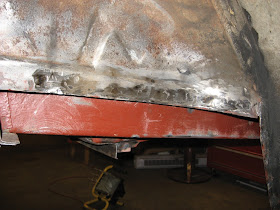Speaking of ugliness check this out. I've ground away the paint and sound deader... stuff... to expose the many spot welds that we're about to do war with. Note the bumper reinforcement bracket welded to the floor and taillight panel. Like the passenger side, this needs to come out first.

Poof! See? That wasn't too hard was it? Same as last time, 4 spot welds around each hole on the taillight panel and 5 seam welds along the tabs on the trunk floor. No reason to stand around gandering at the greatness that is our angle grinder now is there? Drill out those spot welds! Same routine as the hundreds of others we've done to this point using my Blair premium 3/8" spot weld cutter.
Sometimes you don't want to see what's skin deep... ya know? I hear it's pretty common for the last 15" or so of the rear frame rails to rust up. No cancer, no foul in my book. There's plenty of structure left so I'm going to grind it, convert it, and encapsulate it.
Ground, converted with Ospho... 
... and encapsulated with ZeroRust.
Now repro parts don't just fit themselves do they? I've already had this in position and have marked the locations of the various flanges. In this case, it was the lower rear quarter flange. The repro drop-offs are a bit oversized so they have to be cut down to match the lower quarter and the spot weld holes are marked 3/8" in from the edge and 2" apart.
Same story for the plug weld holes along the frame rail and center trunk transition panel.
As much as I'd like to go stampeding off to weld in the new part I still have some preparation work to do. I learned a lesson from the passenger side along the wheel well. It seems the old spot welds rust away a bit so I spent a lot of time on that side chasing blowouts. Well, it's no better on the driver side as you can see.
I decided to take further advantage of the inner wheelhouse panels that I've already used for patching the front inner wheelhouse a few months ago. After all, they still have perfectly good flanges don't they? Not for long. Here I've marked the victim for a flange-ectomy.
I cut away everything that didn't look like the new patch... and then a little bit too much more... and tacked it in place.
Gap? What gap? I don't see any gap. I butt welded it all the way and then ground it smoothe.
And finally drilled the plug weld holes for the new trunk panel.
Okay with everything prepared, including a quick color change of the new trunk floor panel, we've finally earned the right to place the new panel in it's new location with a little help from my friends Clamp and Cleco. This time around, after conferring with a very knowledgable guy on the VMF, I omitted the seam sealer between the flanges this time. I will instead leave the outside-facing overlap unsealed but seal the inside-facing flange with normal exterior seam sealer.
I'm not sure of the most proper weld sequence but I chose the top of the frame rail and center trunk transition panel flange first.
Then the drop-offs.
And the inner wheel house last. I actually ground the welds all as one batch but the pictures show the semi-finished welds.
After the floor was fully welded in and the welds ground down, I applied weld-through primer and then re-welded the bumper bracket last by seam welding the 5 tabs...
...and plug-welding the 8 spot welds previously drilled out followed up by some grinding.
So now the back of the car is pretty much patched up with the exception of a few small spots left open during the floor install. Let's have a moment of silence to remember the sacrifices suffered by our fallen comrades, the not-fully-utilized-panels.
And of course, we can't forget Ford's tribute to tetanus. This completes the majority of welding tasks that this car has to endure. The rest from here on out is pretty much the refurbishing of existing parts and panels.
This completes the majority of welding tasks that this car has to endure. The rest from here on out is pretty much the refurbishing of existing parts and panels.







































